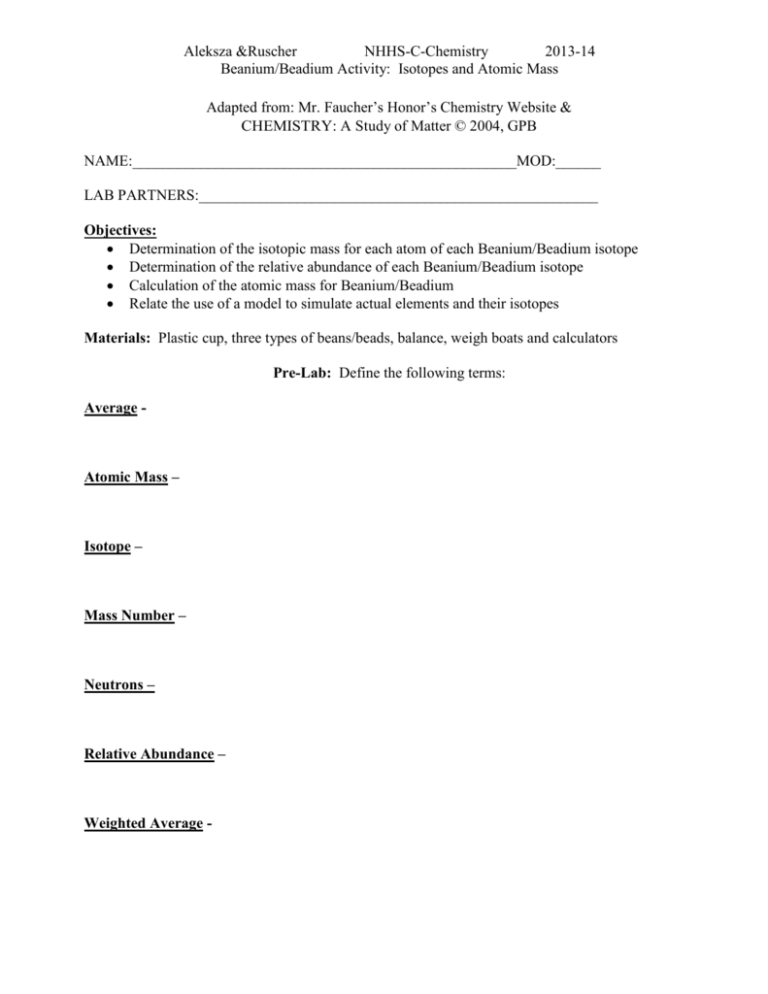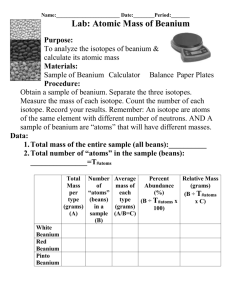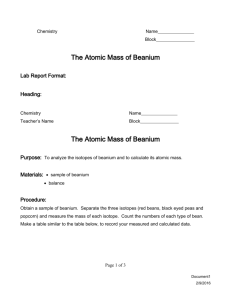Isotope Lab
advertisement

Aleksza &Ruscher NHHS-C-Chemistry 2013-14 Beanium/Beadium Activity: Isotopes and Atomic Mass Adapted from: Mr. Faucher’s Honor’s Chemistry Website & CHEMISTRY: A Study of Matter © 2004, GPB NAME:___________________________________________________MOD:______ LAB PARTNERS:_____________________________________________________ Objectives: Determination of the isotopic mass for each atom of each Beanium/Beadium isotope Determination of the relative abundance of each Beanium/Beadium isotope Calculation of the atomic mass for Beanium/Beadium Relate the use of a model to simulate actual elements and their isotopes Materials: Plastic cup, three types of beans/beads, balance, weigh boats and calculators Pre-Lab: Define the following terms: Average - Atomic Mass – Isotope – Mass Number – Neutrons – Relative Abundance – Weighted Average - Introduction: A new element has been discovered and it is your responsibility to learn the following about the element: • the number of naturally occurring isotopes present in the element • the percentage of each isotope present in your sample of the element • the atomic mass of the element Procedure: Obtain a sample of the element from your teacher and record its ID number above the chart. Count the total number of atoms in your sample and record in the space labeled as such beside the blank for the ID#. Separate the element into its different isotopes. Assign each isotope a letter to identify it and record this letter in the first column of the chart. Count the number of atoms of each isotope and record in the second column of the chart. Mass each isotope group of atoms and record in the third column under "Mass of Isotope Group”. Calculate the average mass of one atom of that isotope (Mass of Isotope Group/ # of atoms of that isotope) and record under "Average Mass of Isotope Group." Calculate the percentage of each isotope present in your element (# of atoms of isotope/total # of atoms in sample) and record in the last column of the chart. DATA TABLE ID NUMBER:______________________ TOTAL NUMBER OF ATOMS:________________ ISOTOPE # of atoms in Isotope Group Mass of Isotope Group Average Mass of Isotope Group Percentage of Isotope Group On the back of this worksheet, determine the average atomic mass of your element using this equation: Be sure to show your work! Average atomic mass = (avg. mass of isotope)(%) + (avg. mass of isotope)(%) + ... (Remember that % means "per 100". In a calculation, 50% becomes 50/100 or 0.50.) Give your element a name and symbol and record the information here. Remember that this is a new element so you, as a scientist, get to name this element whatever you want! Element Name: ________ _ Symbol ____ Atomic Mass:__________ Post Lab Questions: 1. Why don’t we divide the sum of the relative masses by the number of different types of isotopes to determine the Atomic Mass? 2. Describe how this lab (model) relates to elements and their isotopes (reality)? 3. What can you conclude from this lab, regarding isotopes?








